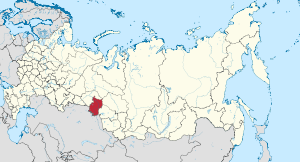Omsk Oblast
|
Omsk Oblast Омская область (Russian) |
|||
|---|---|---|---|
| — Oblast — | |||
|
|||
|
|
|||
|
|||
|
|
|||
| Political status | |||
| Country | Russia | ||
| Federal district | Siberian | ||
| Economic region | West Siberian | ||
| Established | December 7, 1934 | ||
| Administrative center | Omsk | ||
| Government (as of March 2011) | |||
| • Governor | Viktor Nazarov | ||
| • Legislature | Legislative Assembly | ||
| Statistics | |||
| Area (as of the 2002 Census) | |||
| • Total | 139,700 km2 (53,900 sq mi) | ||
| Area rank | 28th | ||
| Population (2010 Census) | |||
| • Total | 1,977,665 | ||
| • Rank | 24th | ||
| • Density | 14.16/km2 (36.7/sq mi) | ||
| • Urban | 71.5% | ||
| • Rural | 28.5% | ||
| Time zone(s) | OMST (UTC+06:00) | ||
| ISO 3166-2 | RU-OMS | ||
| License plates | 55 | ||
| Official languages | Russian | ||
| Official website | |||
|
|
|---|
Omsk Oblast (Russian: О́мская о́бласть, Omskaya oblast) is a federal subject of Russia (an oblast), located in southwestern Siberia. The oblast has an area of 139,700 square kilometers (53,900 sq mi). Its population is 1,977,665 (2010 Census) with the majority, 1.15 million, living in Omsk, the administrative center.
The oblast borders with Tyumen Oblast in the north and west, Novosibirsk and Tomsk Oblasts in the east, and with Kazakhstan in the south.
Archeological findings indicate that the present day territory of the oblast has been inhabited for the last 14,000 years. Neolithic societies in the area lived by fishing and hunting. About three thousand years ago, pastoralism began to take hold.
Various Turkic states dominated the area throughout the Medieval era. The most notable of these were the Western Turkic Khaganate and the Siberian Khanate. Siberian Tatars, Mongols, Khanty and Mansi tribes, along with others, inhabited the territory.
The Russian history of Omsk began with the 1584 arrival of a Cossack force under the command of ataman Yermak, who defeated local rulers and established nominal Russian control of the area. To support further expansion tsars Feodor I and Boris Godunov initiated the construction of fortified settlements and military outposts in the south of Siberia in order to defend their subjects from raiding nomadic tribesmen and to exert authority over local populations, specifically over the tribute-paying Siberian Tatars of The Baraba Lands. The first permanent Russian settlement in the region, the сity of Tara, was founded in 1594, soon it began to play an important part in fur trade that connected Russia with Central Asia and China.
...
Wikipedia



